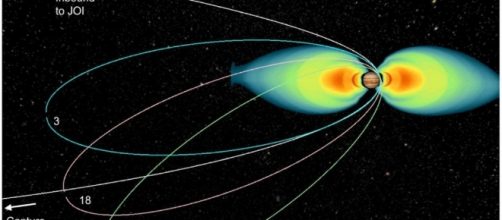Juno is 1.9 million km (1.2 million miles) from reaching Jupiter´s orbit insertion. The Spacecraft´s speed, relative to Jupiter, is 44 million km (27.365 million miles) per hour and relative to earth, its 108,3 million km (67,341 million miles) per hour. On July 4 at around 9:00 PM, (12:00 AM EDT, July 5th), Juno´s main engine firing up will be complete, placing the spacecraft in an orbit around Jupiter.
Orbit insertion
At about 6:00 PM PDT (9:00 PM EDT), Juno turns away from the sun, in reparation for the insertion, 72 minutes later, another turn, placing it in position for the maneuver.
At 7:41 PM PDT (10:41 EDT), the spacecraft main antenna is switched to low gain at 7:56 PM PDT (10:56 PM EDT), Juno change from spinning 2 to a spin of 5 times revolution per minute.
The spacecraft main engine burn will start at 8:18 PM PDT (11:18 PM EDT), slowing Juno so it can be captured by Jupiter´s gravity, changing its velocity to 1, 95 km (1, 2 miles) per second. Juno´s insertion into Jupiter´s orbit is always viewed from earth, permitting the process to be monitored by NASA´s mission team. After this maneuver, Juno will spin down again from 5 RPM to 3 RPM.
Juno's first two trips around Jupiter will consist of two 53.5 days orbits. This types of orbits allow the spacecraft to save power, as opposed to the 14 day orbit, which Juno will go into after the two long orbits are complete.
On October 19, Juno will go into the final engine burn which will pace it into a 14 day orbit around the gas giant, after which the spacecraft will perform its first Science investigations of the planet.
Scientific goals
The mission´s primary goals are projected to improve scientists´ understanding of the formation and evolution of Jupiter.
Juno´s science instrument´s intend to take a look at Jupiter’s atmosphere and determine its composition. The spacecraft will study Jupiter´s gravity and magnetic fields and its magnetosphere, including the auroras at the poles. This will provide new clues at how the planet has evolved since its formation and how its magnetic field affects the atmosphere.

